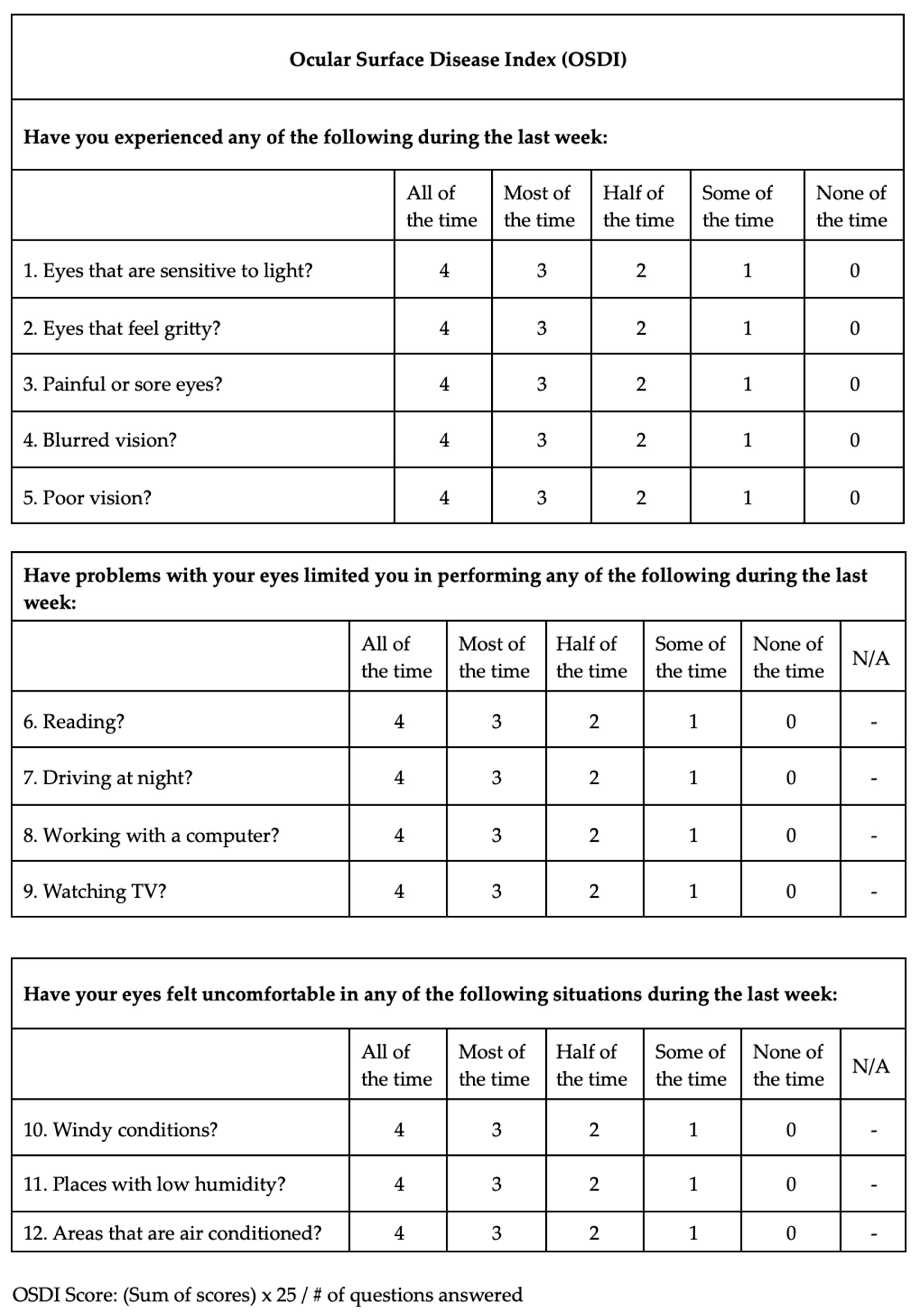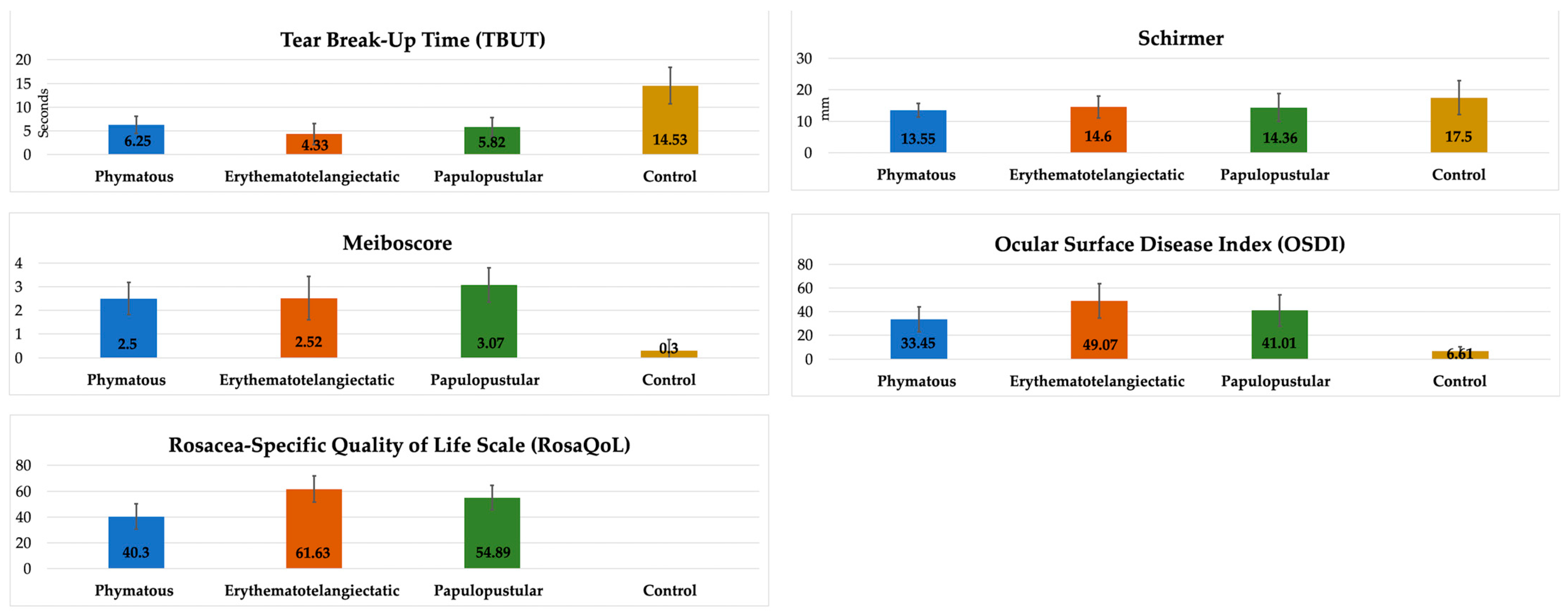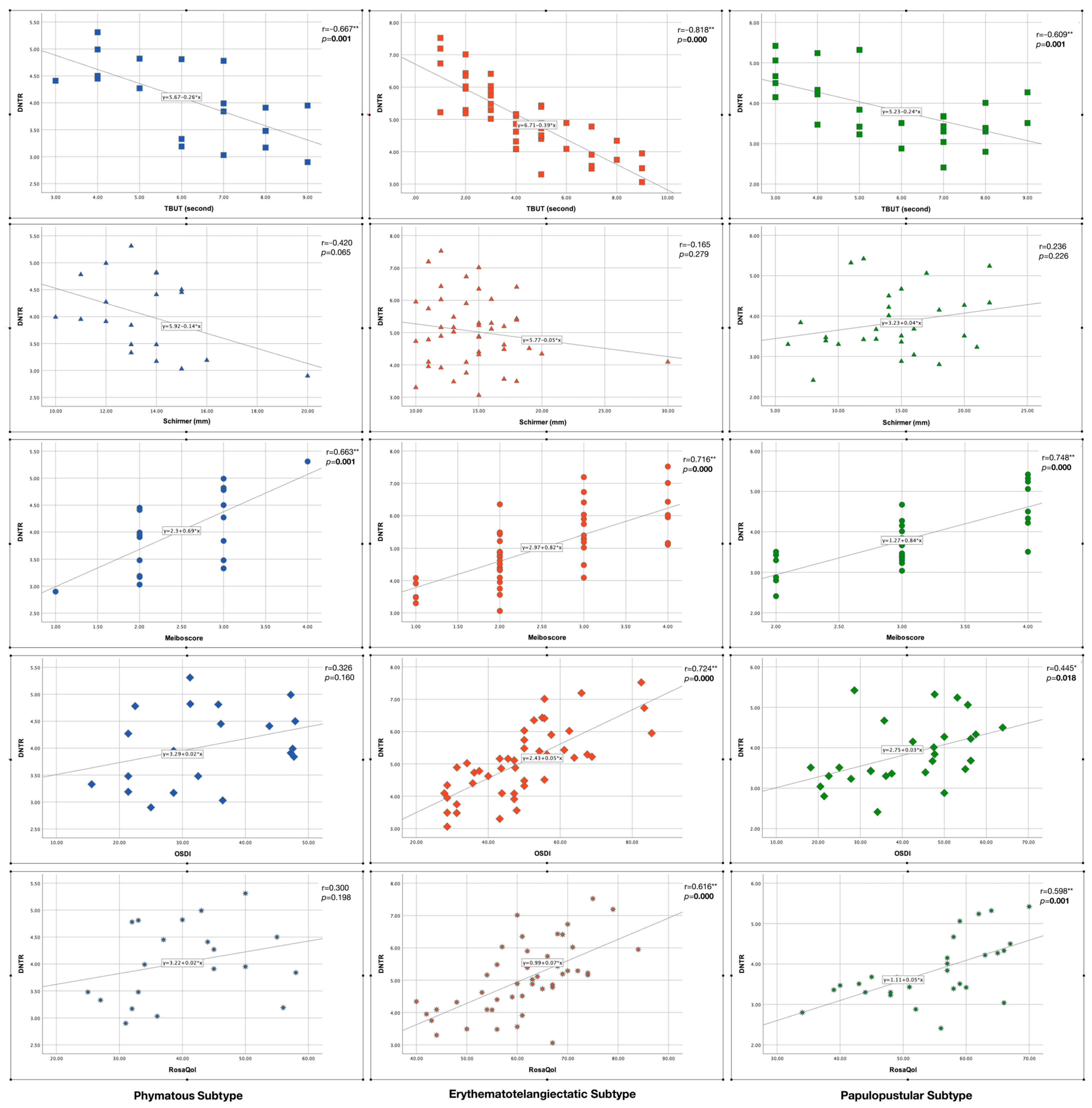Investigation of Thiol/Disulfide Homeostasis and Clinical Parameters in Rosacea Patients According to Skin Subtypes
Abstract
1. Introduction
2. Materials and Methods
2.1. Study Participants
2.2. Exclusion Criteria
2.3. Clinical Data Collection
2.4. Serum Collection
2.5. Biochemical Analysis
2.6. Statistical Analysis
3. Results
4. Discussion
Author Contributions
Funding
Institutional Review Board Statement
Informed Consent Statement
Data Availability Statement
Conflicts of Interest
References
- Gold, L.M.; Draelos, Z.D. New and Emerging Treatments for Rosacea. Am. J. Clin. Dermatol. 2015, 16, 457–461. [Google Scholar] [CrossRef]
- van Zuuren, E.J. Rosacea. N. Engl. J. Med. 2017, 377, 1754–1764. [Google Scholar] [CrossRef] [PubMed]
- Wilkin, J.; Dahl, M.; Detmar, M.; Drake, L.; Feinstein, A.; Odom, R.; Powell, F. Standard classification of rosacea: Report of the National Rosacea Society Expert Committee on the Classification and Staging of Rosacea. J. Am. Acad. Dermatol. 2002, 46, 584–587. [Google Scholar] [CrossRef] [PubMed]
- Redd, T.K.; Seitzman, G.D. Ocular rosacea. Curr. Opin. Ophthalmol. 2020, 31, 503–507. [Google Scholar] [CrossRef]
- Vassileva, S.; Tanev, I.; Drenovska, K. Rosacea: The eyes have it. Clin. Dermatol. 2023, 41, 528–536. [Google Scholar] [CrossRef] [PubMed]
- Vieira, A.C.; Höfling-Lima, A.L.; Mannis, M.J. Ocular rosacea—A review. Arq. Bras. Oftalmol. 2012, 75, 363–369. [Google Scholar] [CrossRef] [PubMed]
- Woo, Y.R.; Cho, M.; Ju, H.J.; Bae, J.M.; Cho, S.H.; Lee, J.D.; Kim, H.S. Ocular Comorbidities in Rosacea: A Case-Control Study Based on Seven Institutions. J. Clin. Med. 2021, 10, 2897. [Google Scholar] [CrossRef]
- Woo, Y.R.; Lim, J.H.; Cho, D.H.; Park, H.J. Rosacea: Molecular Mechanisms and Management of a Chronic Cutaneous Inflammatory Condition. Int. J. Mol. Sci. 2016, 17, 1562. [Google Scholar] [CrossRef] [PubMed]
- Ahn, C.S.; Huang, W.W. Rosacea Pathogenesis. Dermatol. Clin. 2018, 36, 81–86. [Google Scholar] [CrossRef]
- Tavassoli, S.; Wong, N.; Chan, E. Ocular manifestations of rosacea: A clinical review. Clin. Exp. Ophthalmol. 2021, 49, 104–117. [Google Scholar] [CrossRef]
- Falay Gur, T.; Erdemir, A.V.; Gurel, M.S.; Kocyigit, A.; Guler, E.M.; Erdil, D. The investigation of the relationships of demodex density with inflammatory response and oxidative stress in rosacea. Arch. Dermatol. Res. 2018, 310, 759–767. [Google Scholar] [CrossRef] [PubMed]
- Tisma, V.S.; Basta-Juzbasic, A.; Jaganjac, M.; Brcic, L.; Dobric, I.; Lipozencic, J.; Tatzber, F.; Zarkovic, N.; Poljak-Blazi, M. Oxidative stress and ferritin expression in the skin of patients with rosacea. J. Am. Acad. Dermatol. 2009, 60, 270–276. [Google Scholar] [CrossRef]
- Khvoryk, D.; Yarmolik, A. Lipid peroxidation and antioxidant protection in patients with papulo-pustular rosacea. Prog. HealthSci. 2015, 5, 54–60. [Google Scholar]
- Oztas, M.O.; Balk, M.; Ogüs, E.; Bozkurt, M.; Ogüs, I.H.; Ozer, N. The role of free oxygen radicals in the aetiopathogenesis of rosacea. Clin. Exp. Dermatol. 2003, 28, 188–192. [Google Scholar] [CrossRef] [PubMed]
- Jones, D.A. Rosacea, reactive oxygen species, and azelaic Acid. J. Clin. Aesthet. Dermatol. 2009, 2, 26–30. [Google Scholar] [PubMed]
- Yesilirmak, N.; Bukan, N.; Kurt, B.; Fatsa, T.; Yuzbasıoglu, S.; Zhao, M.; Hosbul, T.; Bourges, J.L.; Behar-Cohen, F. Toll-like receptor-4 expression and oxidative stress in ocular rosacea. Mol. Vis. 2023, 29, 357–364. [Google Scholar] [PubMed]
- Marrocco, I.; Altieri, F.; Peluso, I. Measurement and Clinical Significance of Biomarkers of Oxidative Stress in Humans. Oxidative Med. Cell. Longev. 2017, 2017, 6501046. [Google Scholar] [CrossRef] [PubMed]
- Erenler, A.K.; Yardan, T. Clinical Utility of Thiol/Disulfide Homeostasis. Clin. Lab. 2017, 63, 867–870. [Google Scholar] [CrossRef] [PubMed]
- Altinkaynak, H.; Kurkcuoglu, P.Z.; Caglayan, M.; Yorgun, M.A.; Yuksel, N.; Kosekahya, P.; Koca, C.; Toklu, Y. A novel marker in acute central serous chorioretinopathy: Thiol/disulfide homeostasis. Int. Ophthalmol. 2018, 38, 175–181. [Google Scholar] [CrossRef]
- Balbaba, M.; Ulaş, F.; Yıldırım, H.; Soydan, A.; Dal, A.; Aydın, S. Thiol/disulfide homeostasis in patients with ocular-active and ocular-inactive Behçet disease. Int. Ophthalmol. 2020, 40, 2643–2650. [Google Scholar] [CrossRef]
- Sener, S.; Akbas, A.; Kilinc, F.; Baran, P.; Erel, O.; Aktas, A. Thiol/disulfide homeostasis as a marker of oxidative stress in rosacea: A controlled spectrophotometric study. Cutan. Ocul. Toxicol. 2019, 38, 55–58. [Google Scholar] [CrossRef] [PubMed]
- Demir Pektas, S.; Cinar, N.; Pektas, G.; Akbaba, G.; Kara, A.; Hancer, H.S.; Demircioglu Duman, D.; Neselioglu, S.; Erel, O.; Yazgan Aksoy, D. Thiol/disulfide homeostasis and its relationship with insulin resistance in patients with rosacea. J. Cosmet. Dermatol. 2022, 21, 2655–2661. [Google Scholar] [CrossRef]
- Durmaz, I.; Turkmen, D.; Altunisik, N.; Uremis, N.; Uremis, M.M.; Sener, S.; Turkoz, Y. Evaluation of serum TWEAK, TRAIL, and oxidative stress markers in rosacea patients. J. Cosmet. Dermatol. 2022, 21, 7050–7055. [Google Scholar] [CrossRef]
- Craig, J.P.; Nichols, K.K.; Akpek, E.K.; Caffery, B.; Dua, H.S.; Joo, C.K.; Liu, Z.; Nelson, J.D.; Nichols, J.J.; Tsubota, K.; et al. TFOS DEWS II Definition and Classification Report. Ocul. Surf. 2017, 15, 276–283. [Google Scholar] [CrossRef] [PubMed]
- Bron, A.J.; de Paiva, C.S.; Chauhan, S.K.; Bonini, S.; Gabison, E.E.; Jain, S.; Knop, E.; Markoulli, M.; Ogawa, Y.; Perez, V.; et al. TFOS DEWS II pathophysiology report. Ocul. Surf. 2017, 15, 438–510. [Google Scholar]
- Muhafız, E.; Aslan Bayhan, S.; Bayhan, H.A.; Colgecen, E.; Gurdal, C. Evaluation of Meibomian Glands in Cutaneous Rosacea. Med. J. SDU 2021, 28, 621–626. [Google Scholar] [CrossRef]
- Schiffman, R.M.; Christianson, M.D.; Jacobsen, G.; Hirsch, J.D.; Reis, B.L. Reliability and validity of the Ocular Surface Disease Index. Arch. Ophthalmol. 2000, 118, 615–621. [Google Scholar] [CrossRef] [PubMed]
- Abramova, L.; Yeung, J.; Chren, M.M.; Chen, S. Rosacea quality of life index (RosaQol) [abstract P45]. J. Am. Acad. Dermatol. 2004, 50, P12. [Google Scholar] [CrossRef]
- Takeda, K.; Kaisho, T.; Akira, S. Toll-like receptors. Annu. Rev. Immunol. 2003, 21, 335–376. [Google Scholar] [CrossRef]
- Alvarenga, L.S.; Mannis, M.J. Ocular Rosacea. Ocul. Surf. 2005, 3, 41–58. [Google Scholar]
- Wladis, E.J.; Adam, A.P. Immune signaling in rosacea. Ocul. Surf. 2021, 22, 224–229. [Google Scholar] [CrossRef] [PubMed]
- Georgescu, S.R.; Mitran, C.I.; Mitran, M.I.; Matei, C.; Popa, G.L.; Erel, O.; Tampa, M. Thiol-Disulfide Homeostasis in Skin Diseases. J. Clin. Med. 2022, 11, 1507. [Google Scholar] [CrossRef] [PubMed]
- Pisoschi, A.M.; Pop, A. The role of antioxidants in the chemistry of oxidative stress: A review. Eur. J. Med. Chem. 2015, 97, 55–74. [Google Scholar] [CrossRef] [PubMed]
- Lugrin, J.; Rosenblatt-Velin, N.; Parapanov, R.; Liaudet, L. The role of oxidative stress during inflammatory processes. Biol. Chem. 2014, 395, 203–230. [Google Scholar] [CrossRef] [PubMed]
- Guler, E.M.; Ozkan, B.N.; Yilmaz, N.; Ozgen, F.P.; Taslidere, N.S.; Aktas, S.; Kucuk, O.S. Increased oxidative stress and imbalance dynamic thiol–disulfide homeostasis in Rosacea. Turk. J. Dermatol. 2022, 16, 120–124. [Google Scholar] [CrossRef]
- Erdogan, H.K.; Bulur, I.; Kocaturk, E.; Saracoglu, Z.N.; Alatas, O.; Bilgin, M. Advanced oxidation protein products and serum total oxidant/antioxidant status levels in rosacea. Postepy Dermatol. Alergol. 2018, 35, 304–308. [Google Scholar] [CrossRef] [PubMed]
- Galluccio, G.; D’Onghia, M.; Malvaso, D.; Lazzeri, L.; Cinotti, E.; Rubegni, G.; Rubegni, P.; Calabrese, L. Advances in the Pathogenesis and Treatment of Rosacea: A Phenotype-Based Therapeutic Approach. Cosmetics 2024, 11, 11. [Google Scholar] [CrossRef]
- Algarin, Y.A.; Pulumati, A.; Jaalouk, D.; Tan, J.; Nouri, K. The role of vitamins and nutrients in rosacea. Arch. Dermatol. Res. 2024, 316, 142. [Google Scholar] [CrossRef] [PubMed]
- Zujko-Kowalska, K.; Masłowska, J.; Knaś-Dawidziuk, M.; Hamulka, J.; Zujko, M.E. Dietary Antioxidants May Support Cosmetic Treatment in Patients with Rosacea. Antioxidants 2024, 13, 381. [Google Scholar] [CrossRef]
- Kitabchi, A.E.; McDaniel, K.A.; Wan, J.Y.; Tylavsky, F.A.; Jacovino, C.A.; Sands, C.W.; Nyenwe, E.A.; Stentz, F.B. Effects of high-protein versus high-carbohydrate diets on markers of β-cell function, oxidative stress, lipid peroxidation, proinflammatory cytokines, and adipokines in obese, premenopausal women without diabetes: A randomized controlled trial. Diabetes Care 2013, 36, 1919–1925. [Google Scholar] [CrossRef]
- Yuzefovych, L.V.; Musiyenko, S.I.; Wilson, G.L.; Rachek, L.I. Mitochondrial DNA damage and dysfunction, and oxidative stress are associated with endoplasmic reticulum stress, protein degradation and apoptosis in high fat diet-induced insulin resistance mice. PLoS ONE 2013, 8, e54059. [Google Scholar] [CrossRef] [PubMed]
- Karaman, Y.K.; Novgorodtseva, T.P.; Yan’kova, V.I. Effects on alimentary high-fat diet on thiol disulfide homeostasis in rats. Bull. Exp. Biol. Med. 2013, 155, 752–756. [Google Scholar] [CrossRef] [PubMed]
- Samet, J.M.; Wages, P.A. Oxidative Stress from Environmental Exposures. Curr. Opin. Toxicol. 2018, 7, 60–66. [Google Scholar] [CrossRef] [PubMed]






| Rosacea Patients (Mean ± SD) | Healthy Controls (Mean ± SD) | p | |
|---|---|---|---|
| Age (Years) | 52.25 ± 6.67 | 51.80 ± 6.89 | 0.75 |
| Gender (male/female) | 33/57 | 9/21 | 0.51 |
| NT (µmol/L) | 428.34 ± 36.46 | 467.05 ± 42.40 | <0.001 |
| TT (µmol/L) | 466.30 ± 38.19 | 493.96± 43.31 | 0.001 |
| Disulfide (µmol/L) | 18.98 ± 4.34 | 13.45 ± 3.04 | <0.001 |
| DNTR | 4.46 ± 1.07 | 2.89 ± 0.67 | <0.001 |
| DTTR | 4.08 ± 0.90 | 2.73 ± 0.60 | <0.001 |
| NTTR | 91.85 ± 1.79 | 94.44 ± 1.21 | <0.001 |
| TBUT (second) | 5.18 ± 2.24 | 14.53 ± 3.84 | <0.001 |
| Schirmer (mm) | 14.30 ± 3.56 | 17.50 ± 3.38 | 0.004 |
| Meiboscore | 2.68 ± 0.84 | 0.30 ± 0.46 | <0.001 |
| OSDI | 43.03 ± 15.52 | 6.61 ± 3.84 | <0.001 |
| RosaQol | 55.45 ± 13.33 |
| Phymatous Subtype | Erythematotelangiectatic Subtype | Papulopustular Subtype | Healthy Controls | |||||||
|---|---|---|---|---|---|---|---|---|---|---|
| Mean ± SD | p | p * | p ** | Mean ± SD | p † | p ‡ | Mean ± SD | p & | Mean ± SD | |
| Age (Years) | 53.87 ± 5.82 | 0.27 | 0.45 | 0.33 | 51.80 ± 6.26 | 0.85 | 0.99 | 52.11 ± 7.76 | 0.87 | 51.80 ± 6.89 |
| Gender (male/female) | 8/12 | 0.71 | 0.81 | 0.47 | 14/26 | 0.89 | 0.66 | 11/19 | 0.58 | 9/21 |
| NT (µmol/L) | 425.53 ± 35.06 | 0.78 | 0.14 | 0.001 | 422.53 ± 40.39 | 0.58 | <0.001 | 439.49 ± 28.59 | 0.04 | 467.05 ± 42.40 |
| TT (µmol/L) | 459.80 ± 38.01 | 0.65 | 0.19 | 0.02 | 464.85 ± 41.71 | 0.36 | 0.014 | 473.26 ± 32.13 | 0.29 | 493.96 ± 43.31 |
| Disulfide (µmol/L) | 17.13 ± 3.35 | 0.001 | 0.82 | 0.004 | 21.10 ± 4.10 | <0.001 | <0.001 | 16.89 ± 3.75 | 0.003 | 13.45 ± 3.04 |
| DNTR | 4.03 ± 0.71 | <0.001 | 0.39 | <0.001 | 5.04 ± 1.07 | <0.001 | <0.001 | 3.84 ± 0.79 | <0.001 | 2.90 ± 0.68 |
| DTTR | 3.72 ± 0.61 | <0.001 | 0.38 | <0.001 | 4.56 ± 0.88 | <0.001 | <0.001 | 3.56 ± 0.67 | <0.001 | 2.73 ± 0.60 |
| NTTR | 92.55 ± 1.23 | <0.001 | 0.38 | <0.001 | 90.88 ± 1.77 | <0.001 | <0.001 | 92.89 ± 1.35 | <0.001 | 94.54 ± 1.21 |
| TBUT (second) | 6.25 ± 1.83 | 0.006 | 0.45 | <0.001 | 4.33 ± 2.24 | 0.007 | <0.001 | 5.82 ± 2.00 | <0.001 | 14.53 ± 3.84 |
| Schirmer (mm) | 13.55 ± 2.16 | 0.21 | 0.46 | 0.007 | 14.60 ± 3.47 | 0.79 | 0.01 | 14.36 ± 4.44 | 0.02 | 17.50 ± 5.39 |
| Meiboscore | 2.50 ± 0.68 | 0.92 | 0.06 | <0.001 | 2.52 ± 0.91 | 0.02 | <0.001 | 3.07 ± 0.72 | <0.001 | 0.30 ± 0.47 |
| OSDI | 33.45 ± 10.56 | <0.001 | 0.09 | <0.001 | 49.07 ± 14.54 | 0.03 | <0.001 | 41.01 ± 13.17 | <0.001 | 6.61 ± 3.84 |
| RosaQol | 40.30 ± 9.84 | <0.001 | <0.001 | 61.63 ± 10.06 | 0.016 | 54.89 ± 9.50 | - | |||
Disclaimer/Publisher’s Note: The statements, opinions and data contained in all publications are solely those of the individual author(s) and contributor(s) and not of MDPI and/or the editor(s). MDPI and/or the editor(s) disclaim responsibility for any injury to people or property resulting from any ideas, methods, instructions or products referred to in the content. |
© 2024 by the authors. Licensee MDPI, Basel, Switzerland. This article is an open access article distributed under the terms and conditions of the Creative Commons Attribution (CC BY) license (https://creativecommons.org/licenses/by/4.0/).
Share and Cite
Yesilirmak, N.; Saritas, O.; Kurt, B.; Neselioglu, S.; Aktas, A.; Erel, O. Investigation of Thiol/Disulfide Homeostasis and Clinical Parameters in Rosacea Patients According to Skin Subtypes. J. Clin. Med. 2024, 13, 4052. https://doi.org/10.3390/jcm13144052
Yesilirmak N, Saritas O, Kurt B, Neselioglu S, Aktas A, Erel O. Investigation of Thiol/Disulfide Homeostasis and Clinical Parameters in Rosacea Patients According to Skin Subtypes. Journal of Clinical Medicine. 2024; 13(14):4052. https://doi.org/10.3390/jcm13144052
Chicago/Turabian StyleYesilirmak, Nilufer, Ozge Saritas, Busra Kurt, Salim Neselioglu, Akin Aktas, and Ozcan Erel. 2024. "Investigation of Thiol/Disulfide Homeostasis and Clinical Parameters in Rosacea Patients According to Skin Subtypes" Journal of Clinical Medicine 13, no. 14: 4052. https://doi.org/10.3390/jcm13144052
APA StyleYesilirmak, N., Saritas, O., Kurt, B., Neselioglu, S., Aktas, A., & Erel, O. (2024). Investigation of Thiol/Disulfide Homeostasis and Clinical Parameters in Rosacea Patients According to Skin Subtypes. Journal of Clinical Medicine, 13(14), 4052. https://doi.org/10.3390/jcm13144052








